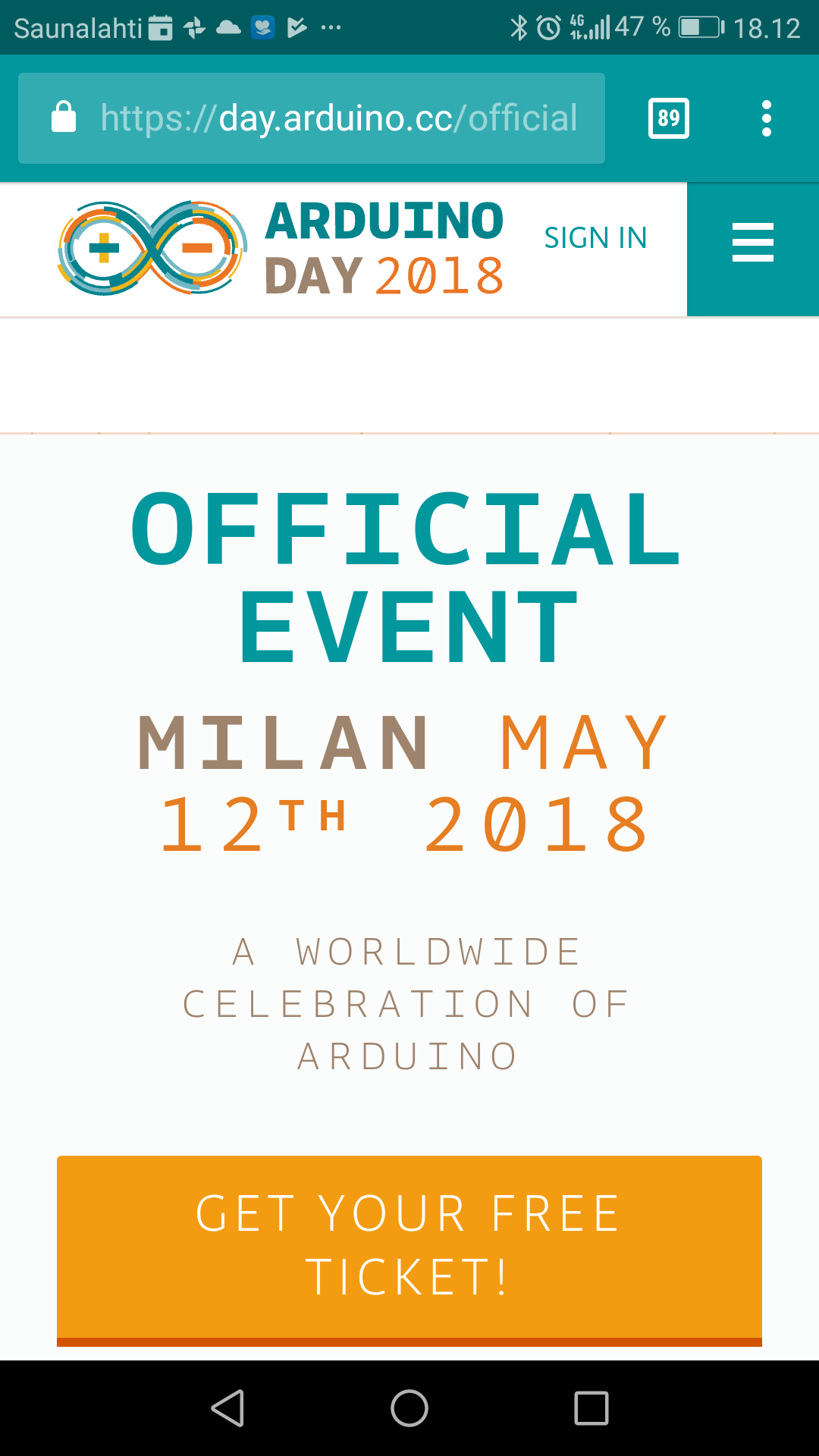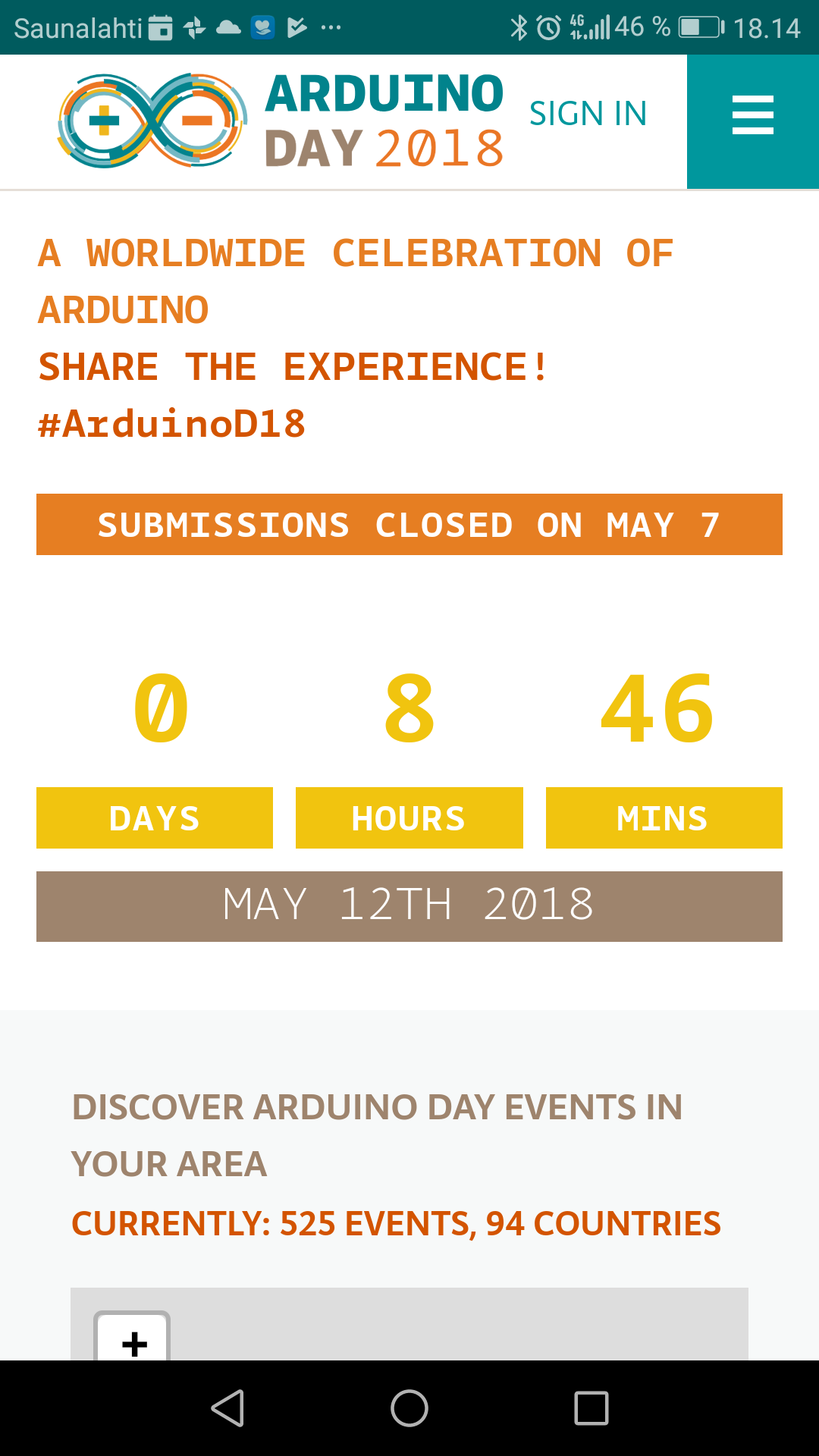https://day.arduino.cc/official
Arduino Day is a worldwide birthday celebration of Arduino. It’s a 24-hour-long event organized by the community and Arduino’s founders, where people interested in Arduino come together.


https://day.arduino.cc/official
Arduino Day is a worldwide birthday celebration of Arduino. It’s a 24-hour-long event organized by the community and Arduino’s founders, where people interested in Arduino come together.


14 Comments
Tomi Engdahl says:
5 questions for Italian interaction designer Massimo Banzi
http://www.ticotimes.net/2018/05/06/5-questions-for-italian-interaction-designer-massimo-banzi
Tomi Engdahl says:
The MKR family gets bigger with two new IoT boards!
ARDUINO TEAM — May 12th, 2018
https://blog.arduino.cc/2018/05/12/the-mkr-family-gets-bigger-with-two-new-iot-boards/
We’re excited to announce two new wireless connectivity boards to help streamline Internet of Things development, the MKR WiFi 1010 and MKR NB 1500.
The first of the boards is the MKR WiFi 1010, which offers low power consumption and has been designed not only to speed up and simplify the prototyping of WiFi-based IoT applications, but also to be embedded in production IoT applications that require WiFi connectivity.
comes equipped with an ESP32-based module manufactured by U-blox.
A significant feature is the MKR1010’s two standalone programmable processors – the first based on ARM processor core technology, the second based on a dual-core Espressif IC
integration of a secure authentication module – Microchip’s ECC508
the MKR NB 1500, which employs the new low-power NB-IoT (narrowband IoT) standard, designed to work over cellular/LTE networks
Designed for global deployment, it supports transmissions via AT&T, T-Mobile USA, Telstra, Verizon over the Cat M1/NB1 deployed bands 2, 3, 4, 5, 8, 12, 13, 20 and 28. The NB-IoT communications technology makes use of existing LTE cellular networks
Tomi Engdahl says:
Not in Milan for Arduino Day? Not a problem!
Tune in to Arduino Day livestream RIGHT NOW! https://bit.ly/2rDgBNU
Tomi Engdahl says:
https://blog.hackster.io/introducing-two-new-boards-from-arduino-f4654b7bd0ec
Tomi Engdahl says:
Honoring Arduino
https://www.eetimes.com/author.asp?section_id=36&doc_id=1333284
Tomi Engdahl says:
I’ll Show You Mine If You Show Me Yours (Arduino Projects)
https://www.eetimes.com/author.asp?section_id=36&doc_id=1333277
Here’s your chance to share your Arduino-based creations with the rest of the Arduino-speaking world.
Following its introduction circa 2003 to 2005, the Arduino has had a tremendous influence on young people, students, and makers of all ages. In celebration of the Arduino and its impact on the world, I’d like to invite you to share your Arduino-based projects with me.
Tomi Engdahl says:
Say hello to the next generation of Arduino boards!
https://blog.arduino.cc/2018/05/17/say-hello-to-the-next-generation-of-arduino-boards/
We’re excited to kick off Maker Faire Bay Area by expanding our IoT lineup with two new boards: the MKR Vidor 4000 and the Uno WiFi Rev 2.
The MKR Vidor 4000 is the first-ever Arduino based on an FPGA chip, equipped with a SAM D21 microcontroller, a u-blox Nina W102 WiFi module, and an ECC508 crypto chip for secure connection to local networks and the Internet. MKR Vidor 4000 is the latest addition to the MKR family, designed for a wide range of IoT applications,
Open Navigation
Show Cart
Blog Home >
Say hello to the next generation of Arduino boards!
Restrict access to tools with this card reader power switch
BLOG HOME
Say hello to the next generation of Arduino boards!
ARDUINO TEAM — May 17th, 2018
We’re excited to kick off Maker Faire Bay Area by expanding our IoT lineup with two new boards: the MKR Vidor 4000 and the Uno WiFi Rev 2.
The MKR Vidor 4000 is the first-ever Arduino based on an FPGA chip, equipped with a SAM D21 microcontroller, a u-blox Nina W102 WiFi module, and an ECC508 crypto chip for secure connection to local networks and the Internet. MKR Vidor 4000 is the latest addition to the MKR family, designed for a wide range of IoT applications, with its distinctive form factor and substantial computational power for high performance. The board will be coupled with an innovative development environment, which aims to democratize and radically simplify access to the world of FPGAs.
“The new MKR Vidor 4000 will finally make FPGA accessible to makers and innovators,” said Massimo Banzi, Arduino co-founder. “And we are looking forward to changing the game yet again.”
“Maker Faire Bay Area is always an unparalleled opportunity to interact with the Arduino community and makers,” added Fabio Violante, Arduino CEO. “This year I’m extremely excited about the launch of the most flexible Arduino ever, the MKR Vidor 4000 and the development environment vision around it. With this new product we aim at putting in the hands of professionals, makers and educators the electronic equivalent of a resourceful Swiss Knife to bring their creativity to the next level. The applications are countless.”
Co-developed with Microchip, the Uno WiFi Rev 2 is built around the new ATmega4809, a u-blox Nina W102 WiFi module, and an integrated IMU. The Uno WiFi will make it even easier to deploy products that need connectivity using the classic Arduino form factor, and is ideal for emerging IoT industries such as automotive, agriculture, consumer electronics, smart home, and wearables. Among its other features, the ATmega4809 provides 6KB of RAM, 48KB of Flash, three UARTS, Core Independent Peripherals (CIPs), and an integrated high-speed ADC. Combined with Microchip’s ECC608 crypto chip
Tomi Engdahl says:
Introducing the MKR Vidor 4000
The first Arduino board with an FPGA
https://blog.hackster.io/introducing-the-mkr-vidor-4000-7b3f50e7f12f
processors on-board. The main Microchip SAM D21 is accompanied by an Intel Cyclone 10 FPGA, alongside a u-blox NINA-W102— an ESP32-based wireless module—to provide both WiFi and BLE connectivity. The MKR Vidor 4000 also has a Microchip ATECC508A cryptographic co-processer providing hardware-based security, and hardware-based key storage, for connecting your projects to the cloud.
Joining the recently announced MKR WiFi 1010 and MKR NB 1500 and extending the boards with the new ‘standard’ Arduino form factor, the MKR Vidor 4000 is the first board from Arduino to have an FPGA on-board.
Tomi Engdahl says:
Introducing the Arduino Uno WiFi
Say “hello!” to the next-generation Arduino Uno
https://blog.hackster.io/introducing-the-arduino-uno-wifi-7118f428ad39
the new Arduino Uno WiFi isn’t just a straight up replacement for the now venerable Arduino Uno. The current Uno is built around an 8-bit Microchip ATmega328P, while the latest is powered by an ATmega4809.
The ATmega4809 is the first AVR device to feature Microchip’s Core Independent Peripherals (CIP), and having this on the Arduino is a perhaps a bigger deal than it appears on the surface.
Yet while CIP support for the new board will no doubt be available in Microchip’s Atmel Studio, or MPLAB X, development environments it’s not yet clear how support will be exposed in Arduino’s own native development environment. Native Arduino library support will no doubt define how much adoption this new feature gets from the community.
The board also provides more RAM (6KB) and Flash (48K) memory, alongside three hardware UARTS
Interesting for a board intended to replace the ‘entry level’ Uno, the new board even has a Microchip ATECC608A cryptographic co-processer
WiFi support has been added to the Uno using the same ESP32-based u-blox module, the NINA-W102, used by the new MKR WiFi 1010
Tomi Engdahl says:
Honoring Arduino
https://www.eetimes.com/author.asp?section_id=36&doc_id=1333284
A note of appreciation to mark the crystal anniversary of the little open-source device that spawned a movement.
The heart and soul of technology is engineering development. Regardless of the advance, no matter the science, nothing matters until it is manifested in a solution that is useful to people. I am fond of using the “tree falls” line in that context, in that the tree could fall and deafen every animal in the forest, but if a person didn’t hear it, it didn’t make a noise. If a technology cannot create a solution, it cannot be called engineering.
That’s why it is so important to laud the Arduino and all it represents. This little open-source device created a new market segment while empowering several other existing and emerging ones. Named after a bar in Ivrea, Italy (drinking and development often go hand in hand — where else to get napkins?), the Arduino Project was started there by a group of students at the Interaction Design Institute Ivrea. Their goal was to create a simple computer to automate projects for people involved in product design both in and out of the engineering community.
It was that “in-and-out” aspect that revolutionized the industry. Prior to the Arduino, there was no low-cost, relatively simple way to embed electronics in anything. If you needed a sensor monitor, you had to build one from scratch. Hobbyists could buy finished subsystems in some populist hobby areas, but if you treaded a centimeter off the beaten path, you were immediately without any general solutions.
Tomi Engdahl says:
https://blog.arduino.cc/2018/05/17/say-hello-to-the-next-generation-of-arduino-boards/
Tomi Engdahl says:
Q&A: Arduino Looks to the Future of Developer Boards for Makers and Professionals
https://electronics360.globalspec.com/article/11853/q-a-arduino-looks-to-the-future-of-developer-boards-for-makers-and-professionals
Tomi Engdahl says:
http://www.etn.fi/index.php/13-news/8024-arduino-kortti-sai-fpga-piirin#ETNartikel
Tomi Engdahl says:
Meet Massimo Banzi: How Arduino enabled the IoT movement
http://www.tfir.io/meet-massimo-banzi-how-arduino-triggered-the-iot-movement/